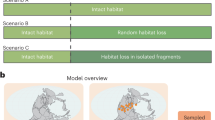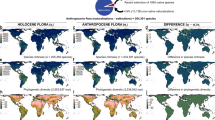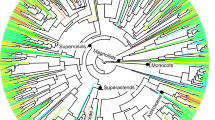Abstract
The unified neutral theory of biodiversity and biogeography1 provides a dynamic null hypothesis for the assembly of natural communities. It is also useful for understanding the influence of speciation, extinction, dispersal and ecological drift on patterns of relative species abundance, species–area relationships and phylogeny. Clark and McLachlan2 argue that neutral drift is inconsistent with the palaeorecord of stability in fossil pollen assemblages of the Holocene forests of southern Canada. We show here that their analysis is based on a partial misunderstanding of neutral theory and that their data alone cannot unambiguously test its validity.
Similar content being viewed by others
Main
Neutral theory in ecology1 builds on the theory of island biogeography3, which asserts that an island or a local community approaches steady-state species richness where there is an equilibrium between the immigration of species from the much larger metacommunity source area and the local extinction of species. The dynamics of a local population are governed by birth, death and immigration events in both neutral and non-neutral models. Under neutrality, at large spatial and temporal scales, Fisher's log-series distribution is the expected steady-state distribution of relative species abundance at the speciation–extinction equilibrium in the metacommunity when the per capita birth and death rates are density independent and the same for all species, and speciation is introduced4.
The characteristic timescale for speciation and evolutionary changes in species is much longer than the 200-generation period studied by Clark and McLachlan. During this relatively short time interval, the large-scale metacommunity distribution of relative species abundance, particularly of common and widespread species, will change slowly or remain nearly constant1.
Clark and McLachlan's analysis2 of the fossil pollen record of the eight local tree communities assumes that the sites are undergoing drift in complete dynamic isolation. However, in common with the theory of island biogeography3, the neutral theory1,4 takes into account the fact that the species composition and the dynamics of local communities will be influenced by immigration from the surrounding metacommunity. When the local community is coupled dynamically to the metacommunity, local communities will covary positively in species composition, and exhibit potentially greater compositional stability than if they drifted in complete isolation, as in Clark and McLachlan's simulations.
Dispersal tends to stabilize local species composition and relative abundances because communities become dynamically coupled to one another. Immigrants belonging to the more abundant metacommunity species will arrive more frequently in the local community than immigrants of rarer species, stabilizing local assemblages and making them more similar. Very fast rates of long-distance dispersal may characterize the northward movements of several tree species following the retreat of the continental ice sheets during the Holocene of Europe5 and North America6.
One question is how stable the metacommunity surrounding these local communities has been over the past 10,000 years (the length of the fossil record considered by Clark and McLachlan2). Large changes were occurring over this time in the post-glacial forests of eastern North America. Whether or not the metacommunity provided a relatively stable backdrop for the dynamics within the sampled local communities is unclear. However, even if the metacommunity was not perfectly constant or was changing gradually and directionally, abundant metacommunity species would be expected to be major components of virtually all local communities, even communities weakly coupled to the metacommunity with relatively slow or infrequent immigration1. A stronger argument for stability inconsistent with neutrality would be to show that local communities persisted in their compositions, despite large changes in the abundances of common species in the metacommunity in which they were embedded.
Figure 1 of Clark and McLachlan2 is based on simulations of neutral dynamics using a lottery model, which the authors claim measures the divergence among sites, over time, that is expected under neutrality and which should continue to increase until diversity is lost through extinction. But we dispute this. In their model, which does not allow for extinction, the variance actually levels off with time, reaching an equilibrium. Thus, they overestimate the accumulation of among-site variance under neutrality.
Moreover, the timescale for equilibration in Clark and McLachlan's simulations is very different from the evolutionary timescales associated with equilibration of biodiversity in the metacommunity. Biodiversity is maintained in equilibrium in neutral theory because of the balance between speciation and extinction of species on very large spatial and temporal scales. The simplified lottery model used as a neutral benchmark by Clark and McLachlan2 does not capture a fundamental result of unified neutral theory1, namely that the fates of all species in the local community differ according to their unequal abundances in the metacommunity.
Clark and McLachlan note that the distributions of many plant species are strongly correlated with climate, hydrology and soil, but such evidence for niche assembly need not preclude a role for demographic stochasticity (ecological drift). But how strong are the deterministic processes structuring ecological communities relative to drift? Although the hypothesis of complete neutrality may often fail (it is, after all, a null hypothesis), we do not agree with Clark and McLachlan's assertion that the strong evidence for stabilizing forces in the palaeorecord2 is sufficient to reject ecological drift. Because their lottery model prevents extinction and ignores dispersal and the dynamic coupling between local communities and the metacommunity, it cannot be regarded as a definitive test of current neutral theory.
References
Hubbell, S.P. The Unified Neutral Theory of Biodiversity and Biogeography (Princeton Univ. Press, Princeton, NJ, 2001).
Clark, J.S. & McLachlan, J.S. Nature 423, 635–638 (2003).
MacArthur, R.H. & Wilson, E.O. The Theory of Island Biogeography (Princeton Univ. Press, Princeton, NJ, 1967).
Volkov, I., Banavar, J.R., Hubbell, S.P. & Maritan, A. Nature 424, 1035–1037 (2003).
Petit, R. J. et al. Forest Ecol. Management 156, 49–94 (2002).
Clark, J. S. et al. Bioscience 48, 13–24 (1998).
Author information
Authors and Affiliations
Corresponding author
Rights and permissions
About this article
Cite this article
Volkov, I., Banavar, J., Maritan, A. et al. The stability of forest biodiversity. Nature 427, 696 (2004). https://doi.org/10.1038/427696a
Issue Date:
DOI: https://doi.org/10.1038/427696a
This article is cited by
-
Stochastic and deterministic processes interact in the assembly of desert microbial communities on a global scale
The ISME Journal (2011)
-
Coral reef diversity refutes the neutral theory of biodiversity
Nature (2006)
-
Neutral theory tested by birds
Nature (2005)
Comments
By submitting a comment you agree to abide by our Terms and Community Guidelines. If you find something abusive or that does not comply with our terms or guidelines please flag it as inappropriate.



